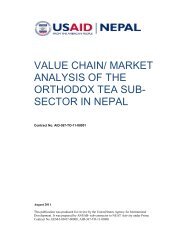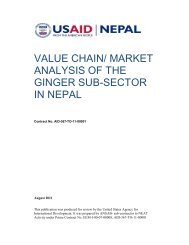value chain/ market analysis of the lentil sub-sector in ... - Nepal Trade
value chain/ market analysis of the lentil sub-sector in ... - Nepal Trade
value chain/ market analysis of the lentil sub-sector in ... - Nepal Trade
You also want an ePaper? Increase the reach of your titles
YUMPU automatically turns print PDFs into web optimized ePapers that Google loves.
5.2.2 Production<br />
High scope to <strong>in</strong>crease productivity: Productivity can be <strong>in</strong>creased by <strong>in</strong>troduc<strong>in</strong>g high<br />
yield<strong>in</strong>g seed varieties and improved cultivation practices like <strong>the</strong> use <strong>of</strong> quality seeds,<br />
weed<strong>in</strong>g, apply<strong>in</strong>g nutrient management, and disease management. Many seed varieties can<br />
be grown throughout <strong>the</strong> Terai and mid hill districts <strong>of</strong> <strong>Nepal</strong> dur<strong>in</strong>g <strong>the</strong> w<strong>in</strong>ter season.<br />
Low amount <strong>of</strong> capital and skill required <strong>in</strong> <strong>lentil</strong> production and storage: Lentil crops<br />
do not need very much capital for production. Even small holders can grow <strong>lentil</strong> crops<br />
easily. Growers have to <strong>in</strong>vest about 60 % <strong>of</strong> <strong>the</strong> total cost <strong>in</strong>to irrigation and labor for<br />
harvest<strong>in</strong>g, w<strong>in</strong>now<strong>in</strong>g, and thresh<strong>in</strong>g. The cost is even lower if farmers use household labor<br />
and grow <strong>in</strong> low lands.<br />
Availability <strong>of</strong> improved varieties: Normally, farmers select <strong>the</strong> seed <strong>of</strong> traditional cultivar<br />
due to a lack <strong>of</strong> knowledge about improved cultivars. There is a lot <strong>of</strong> room for improvement<br />
<strong>in</strong> terms <strong>of</strong> <strong>in</strong>creas<strong>in</strong>g yield simply by select<strong>in</strong>g <strong>the</strong> appropriate cultivar with high<br />
productivity.<br />
Availability <strong>of</strong> f<strong>in</strong>ancial <strong>in</strong>stitutions at district level: There are three or four f<strong>in</strong>ancial<br />
<strong>in</strong>stitutions <strong>in</strong> each <strong>lentil</strong> grow<strong>in</strong>g district. The number is even higher <strong>in</strong> central Terai<br />
districts.<br />
Provision <strong>of</strong> f<strong>in</strong>anc<strong>in</strong>g at cooperative level: There are community level cooperatives <strong>in</strong><br />
each district. Additionally, new cooperatives have been emerg<strong>in</strong>g <strong>in</strong> each <strong>lentil</strong> grow<strong>in</strong>g<br />
district every day. Many times, cooperatives will <strong>of</strong>fer f<strong>in</strong>anc<strong>in</strong>g at a low <strong>in</strong>terest rate.<br />
Availability <strong>of</strong> research and extension services: There are many NGOs and government<br />
<strong>in</strong>stitutions work<strong>in</strong>g <strong>in</strong> <strong>the</strong> <strong>lentil</strong> <strong>sub</strong>-<strong>sector</strong> <strong>in</strong>clud<strong>in</strong>g: DADOs, FORWARD, LIBIRD,<br />
PACT, NARDF and NARC. Resources can be optimized through coord<strong>in</strong>ation and<br />
collaboration among <strong>the</strong>se programs and projects.<br />
5.2.3 Process<strong>in</strong>g<br />
Availability <strong>of</strong> high-tech process<strong>in</strong>g technologies: Currently, about 18 high-tech process<strong>in</strong>g<br />
mills are operat<strong>in</strong>g <strong>in</strong> <strong>Nepal</strong>. These process<strong>in</strong>g units are centrally located close to <strong>the</strong> Indian<br />
boarder and have access to transportation and communication facilities with <strong>the</strong> entire world.<br />
Each process<strong>in</strong>g unit has a capacity <strong>of</strong> about 4-5 ton/hrs with sort<strong>in</strong>g and grad<strong>in</strong>g abilities.<br />
5.2.4 Market<strong>in</strong>g<br />
Value addition through clean<strong>in</strong>g and grad<strong>in</strong>g at farmer’s level: In order to atta<strong>in</strong><br />
competitive prices, farmers must follow basic post-harvest hand<strong>in</strong>g practices like clean<strong>in</strong>g,<br />
dry<strong>in</strong>g, grad<strong>in</strong>g and packag<strong>in</strong>g. These activities are simple, but many farmers are reluctant to<br />
put <strong>in</strong> <strong>the</strong> extra effort.<br />
Scope to develop a niche <strong>market</strong> for organic and natural <strong>lentil</strong>: Currently, <strong>the</strong> use <strong>of</strong><br />
pesticides, chemical fertilizers, and herbicides <strong>in</strong> <strong>lentil</strong> crop is almost non-existent at <strong>the</strong> farm<br />
level. There is <strong>in</strong>creas<strong>in</strong>g trend for consum<strong>in</strong>g organic <strong>lentil</strong>s, particularly <strong>in</strong> developed<br />
countries. <strong>Nepal</strong> can harness this opportunity through explor<strong>in</strong>g <strong>Nepal</strong>i organic <strong>lentil</strong>;<br />
particularly <strong>in</strong> EU and U.S. <strong>market</strong>s.<br />
Value Cha<strong>in</strong>/ Market Analysis-Lentils 26






